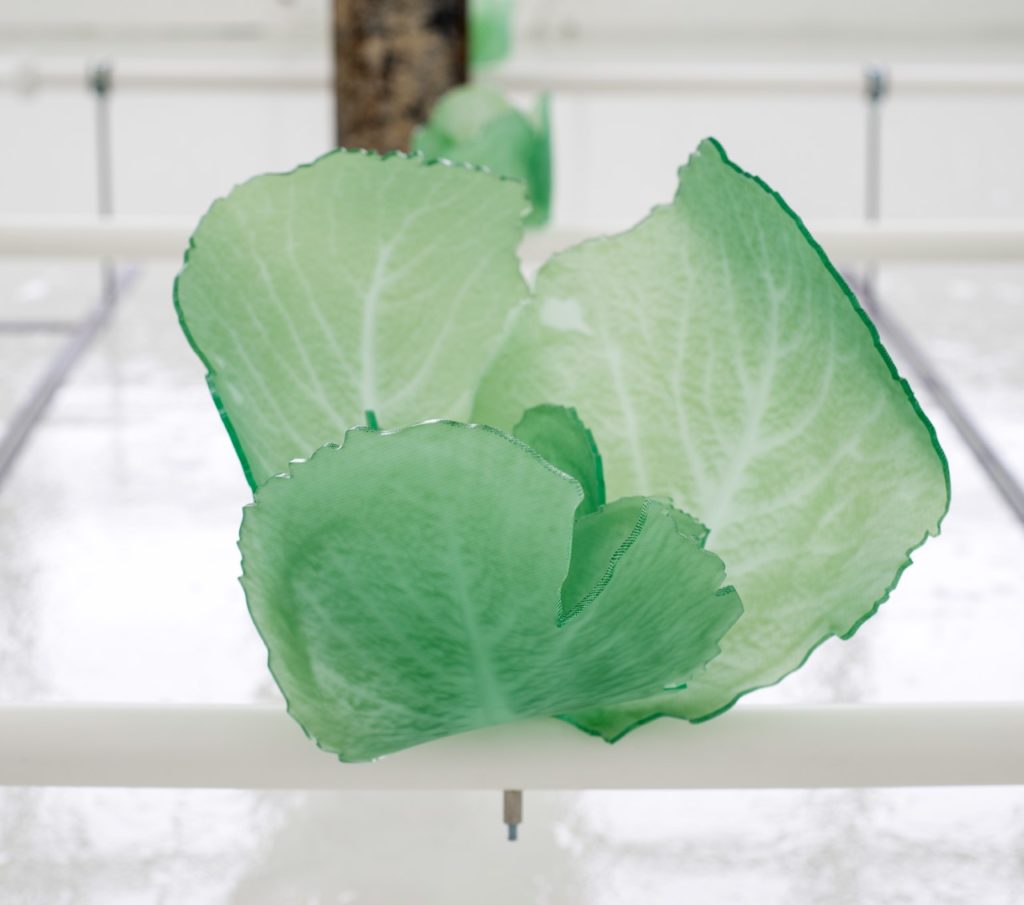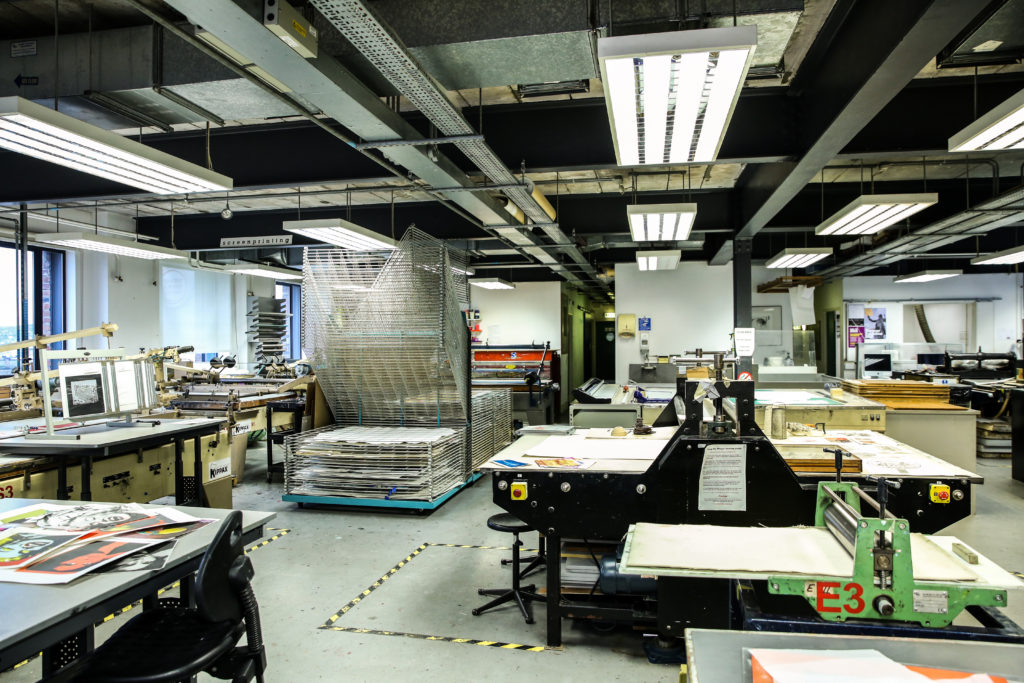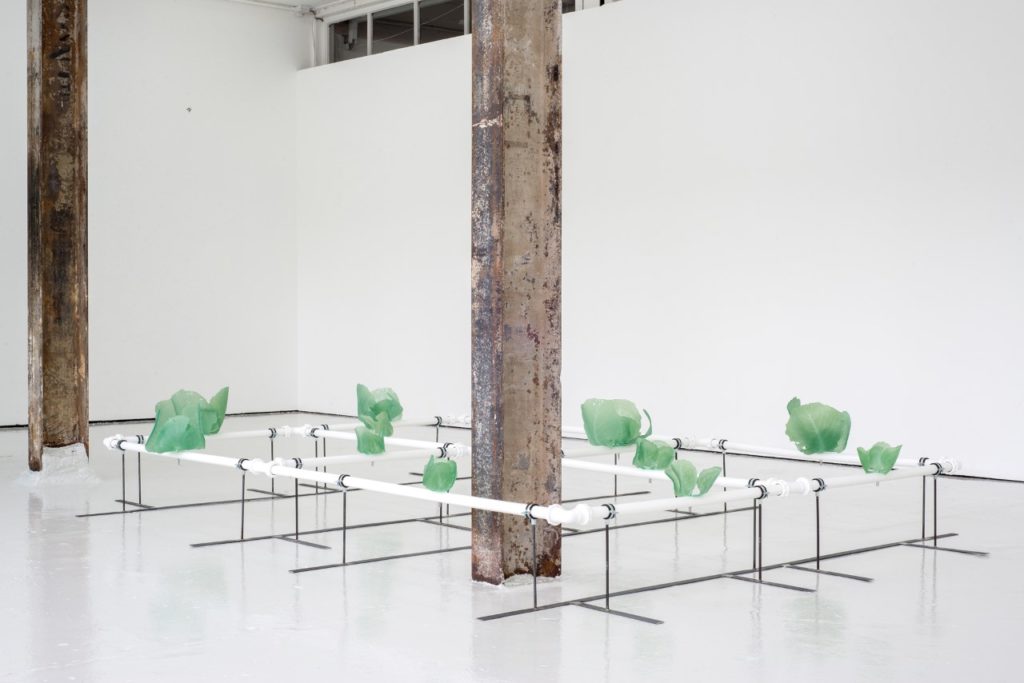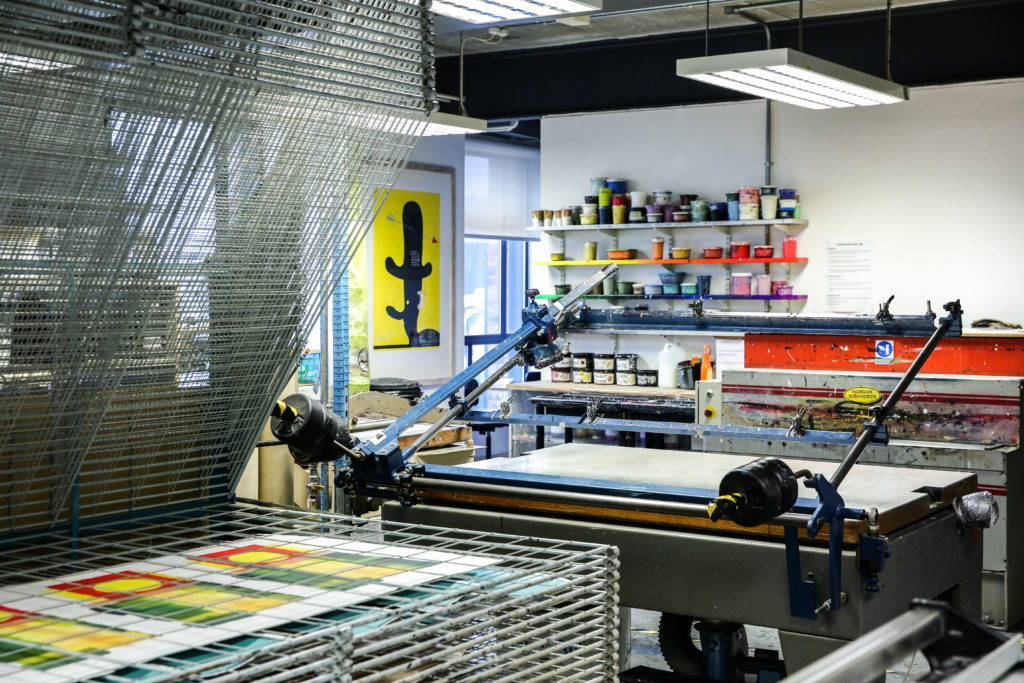The Tate British Art Network Contemporary Art in Scotland sub-group had planned to hold a research event at the Dundee Contemporary Arts Print Studio in March 2020, but it was cancelled due to the COVID-19 pandemic. Here, artist Rachel Adams, who had been due to participate in the session, reflects on print practice and the ongoing crisis.
I am an artist based in Glasgow and have been with the DCA Print Studio since 2017. The research has been funded by the Arts and Humanities Research Council (AHRC) and is supported by the University of Edinburgh. The work I have undertaken at DCA Print Studio has been a chance to bring print to my existing sculptural practice and experiment and play with different technologies they offer. In this project I have been exploring the history of women’s work and technology and where this intersects with the processes and techniques of print and printmaking. I have concentrated on using craft and print processes to create objects based on computer technologies alongside botanical and entomological imagery. Many works combine analogue print techniques with plastics and textiles alongside the digital methods which the Print Studio has including scanning, laser cutting or and vinyl plotting.

As DCA Print Studio has been closed since March 2019, I have found myself missing my journeys to Dundee, but not for the reasons that I would have thought. When printmaking I often materialise the images that I have made on my computer with different processes, enjoying the intersection between what are essentially digital images, sometimes scanned objects or images created with drawing software, and the materiality of analogue print processes. But although I long to get my hands dirty, turning pictures I see on the screen into something physical, I have found what I miss more than anything is the structured support the DCA Print Studio offers.
Like so many during this crisis, I am currently working from home. I am very fortunate, but even with no illness or loss of income, or caring responsibilities, I have struggled. I think of myself as an organised person, but this falls apart when working in my living space. My days are unplanned and untimetabled, moving seamlessly between domestic tasks to work with a single step. I leave little half completed projects around the house with coffee cups and phone chargers alongside drawings and note-books. My flat is littered with these small piles, often outlining the shape of the body that attempted to work there. At certain points, particularly when my studio was closed, I wondered from my bedroom to my lounge, becoming more and more irritated at the sight of my own entropy. Work and life became entirely indistinguishable and, the longer this continues, are becoming more and more difficult to pull apart.

By contrast, working in the print studio provides an immediate timetable. Printmaking, more than any other type of art making I engage with, has implicit structure. Drying times and complex processes dictate how much can be done in a day. The laser cutter can take hours to finish a detailed image or engraving, and cleaning quick-drying ink means that you can only take on one task at once. The processes keep the tasks in a clear and clean order. As a result, I find it far easier to implement the schedule a good day needs, without being sucked into a distracted world of email-cum-research.
Also, the print studio is well-organised. All the items you need from sponges to screens to presses and plates ready for use. Although it would be easy to think this could give working there an uncreative air, in these restraints I have found great freedom. A plethora of various different papers fill the shelves to be selected and there is always someone available to run an idea past or help with a talk through a problem. Despite already knowing that one of the things I loved about the Print Studio was this level of structured support, I have been struck by just how much, in this a-temporal soup-like existence I now inhabit, structure is the thing I crave most.
But I was beginning to think about daily structure and making space long before the restrictions of 2020. As I have already described, working from home is not everyone’s solution to a happy work-life balance. For artists the collapse of art and life is an issue even without the restrictions of a global pandemic. The inability to be able to pull them apart can manifest at home or in a studio space, as your finances, feelings and dreams for both are deeply embedded. Take Adrian Piper’s Job Description (2001) for example, a six hundred word text where she describes the variety of tasks required to do her ‘job,’ from the secretarial and domestic to the operative and the philosophical [1]. Or American painter Frances Stark, who describes the distraction her domestic space she begins to imagine all the ways that it could become more organised or beautiful in a quest for efficient working: ‘I am sparing you the details of toil which aspires to productivity; suffice to say it’s not hard to experience, on a regular basis, the loneliness, the anxiety, the constant urge to redecorate I imagined a housewife might feel’ (31) [2].

As rents rise in flats and studio spaces across the country, I wonder what the future of having access to any space individual space will be like for artists. The day I write this house prices in the UK have reached an all-time high with the average cost of a house now standing at £245k. The consequences of this will presumably be felt in renting stock and commercial buildings in due course, creating a more untenable situation for everyone. But for those wanting to pursue their artistic practices, space will be harder to come by. I am a strong believer that the recipe for good creative work still relies on the deceptively simple ingredients Virginia Woolf first described in 1927: ‘money and a room of one’s own’ [3]. As we slide headlong into a recession, both of these elements seem more and more unattainable as housing cost rises and you need even more to just scrape by. To have money or a room you may require another job, or need to take on full time employment rather than pursuing freelance, part time work, where commitment to a practice can be facilitated. Whilst this is not a new issue, patronising calls for us to retrain are certainly not any form of answer.
In fact, all of these scenarios require giving up space, when space is what practices need. Increased housing costs can mean you lose the physical space of the studio which you can no longer, or never could afford, and the increased work demands squeeze your time. Not only does this impact literal space to make and do with enough room to see what you are doing and generate good decisions informed by open surroundings. But also the cognitive space as well. Here the luxury of spending time on that practice, where you have the chance to think, is diminished by the hustle needed in hard times.
Better thinkers than I can tackle this problem, but I do wonder if the print studios and other production facilities can provide a kind of stop gap. In Scotland, DCA Print Studio is part of a network of production facilities which includes other print studios such as Edinburgh Printmakers and Glasgow Print Studios and the Scottish Sculpture workshop, to name but a few. These facilities are well-used and well-loved for those deeply interested in particular processes or wanting to learn a new skill. There are also other models for sharing equipment and knowledge including web-based platforms Glasgow Tool Library and Circular Arts Network, as well as the tradition of weaving Harris Tweed not in a mill, but on treadle looms in the islanders’ homes [4]. But can these resource also provide a way to continue practice without the pressures on the domestic dwelling or the cost of private space?

One obvious difference is that compared to the private space of a bedroom or studio, a production facility is a shared area where you interact with other members of the public. Sometimes this visible and public art making is wonderful, where conversation and the ideas of others mingle with your own to produce results better than the sum of their parts. At other points, usually when work isn’t going well, you wish for that lonely space, somewhere private to resolve those problems and figure stuff out on your own. Private or public, the conditions are never going to be consistently conducive to good work. Social distancing may make the print studio more like the private studio, with new restrictions limiting the numbers of people who can work in a space at once. But what will not have changed is the structure. The processes and set ups will continue to provide the timetable – one aspect of pre-lockdown life that I for one am glad can be kept precisely the same.
Rachel Adams, January 2021
Notes
[1] Piper, Adrian. ‘APRAF Berlin: Job Description’. Adrian Piper, 2001. http://www.adrianpiper.com/job_description.shtml.
[2] Stark, Frances. ‘The Architect & the Housewife’. Atelier Michael Lin, 1998. https://ateliermichaellin.com/articles/frances-stark–the-architect-the-housewife.
[3] Woolf, Virginia, A Room of One’s Own, (London: Hogarth Press) 1935.
https://archive.org/details/woolf_aroom
[4] Both Glasgow Tool Library https://www.facebook.com/glasgowtoollibrary/ and Circular Arts Network https://www.canarts.org.uk/ have been set up in the last few years by artists for artists to support art production, equipment and knowledge sharing and in Scotland. Harris Tweed can only be made in the Outer Hebrides and relies on a community of textile workers. Large beams are warped up in the mills and sent out daily to be delivered to the weavers who complete the cloth on their looms at home. For more information see https://www.harristweed.org/the-process/ and the short film Harris Tweed: A Hand Woven Heritage (2016) available at https://vimeo.com/155374295.
